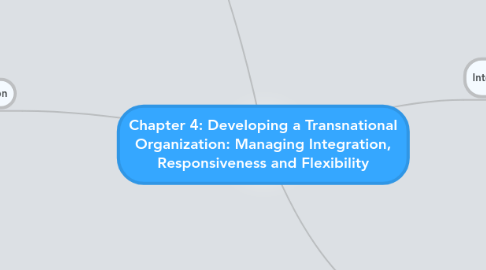
1. Building a Transnational Organization
1.1. Anatomy (Structure)
1.1.1. Administrative Heritage
1.1.1.1. Historical Organizational Configuration Models
1.1.1.1.1. Decentralized Federation
1.1.1.1.2. Coordinated Federation
1.1.1.1.3. Centralized Hub
1.1.2. Administrative Heritage vs. Transnational Organization
1.1.2.1. Global Strategy
1.1.2.2. Multinational Strategy
1.1.2.3. International Strategy
1.1.3. Transnational Organizations
1.1.3.1. Multidimensional Perspectives
1.1.3.1.1. National subsidiary management
1.1.3.1.2. Global Business management
1.1.3.1.3. Worldwide functional Management
1.1.3.2. Distributed, Interdependent Capabilities
1.1.3.2.1. Integrated Network
1.1.3.3. Flexible Integrative Processes
1.1.3.3.1. Interdependent Management Processes
1.2. Physiology (Systems and Processes)
1.3. Psychology (Culture and Management Mentality)
1.3.1. Clear, shared understanding of the company's mission and objectives
1.3.2. Visible behavior and public actions of Managers
1.3.3. Personnel policies, practices and systems
2. Managing the Process of Change
2.1. Traditional Change Process
2.2. Emerging Change Process
3. International Structural Stages Model
3.1. Two axis
3.1.1. Foreign Product Diversity
3.1.2. Foreign Sales as a Percentage of Total Sales
3.2. Stages
3.2.1. Early Stage
3.2.1.1. Manage overseas operations through an 'international' division
3.2.2. Afterwards
3.2.2.1. Expand abroad by entering several countries with a limited product range
3.2.2.1.1. Adopt Area Structure
3.2.2.2. Enter few countries but increase product diversity
3.2.2.2.1. Adopt Product division structure
3.2.2.3. Enter several countries and increase product diversity
3.2.2.3.1. Adopt Global Matrix

